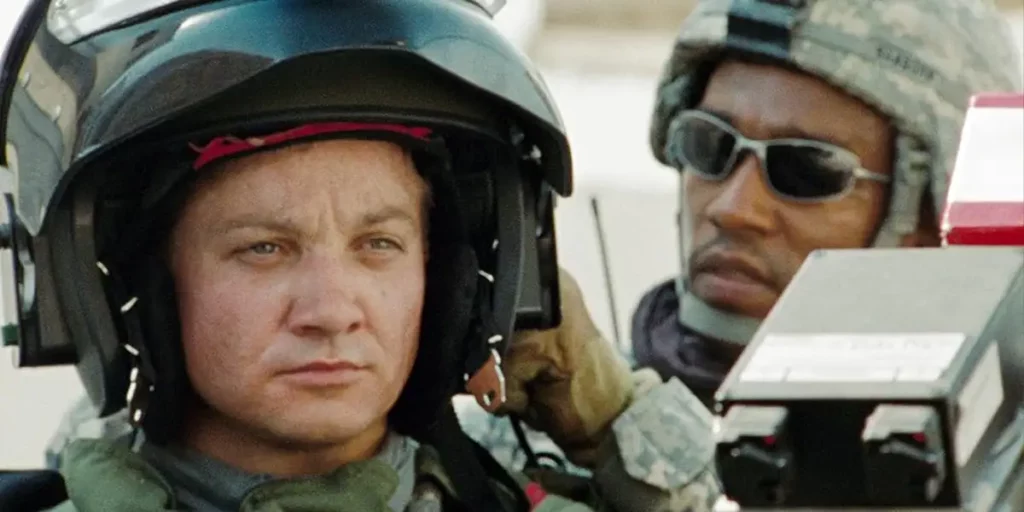On its 15th anniversary, Kathryn Bigelow’s The Hurt Locker is a film that still expertly uses metaphor to engage with the psyche of soldiers, even if it now glaringly omits Iraqi trauma.
Director: Kathryn Bigelow
Genre: Drama, Thriller, War
Run Time: 131′
US Release: June 26, 2009
UK Release: August 28, 2009
Where to watch: on digital and on demand
With “war is a drug” the lasting impression of its opening quote, – “the rush of battle is often a potent and lethal addiction, for war is a drug”, from journalist and Presbyterian minister Chris Hedges – Kathryn Bigelow’s The Hurt Locker establishes a prevailing metaphor almost immediately. A simplistic viewing of the film it may be, it’s one that still feels fitting 15 years since the film’s first release, even if a lot of its anti-war messaging has lost its edge.
Attitudes towards the Iraq war have shifted considerably in the intervening decades. Righteous, complicated, illegal and senseless, its murkiness is something that Hollywood has never shied away from. While The Hurt Locker is more character portrait than philosophical commentary, it is not completely without sentiment. It’s a film focused on the impact of combat, on how constant vigilance, thrill and danger takes its toll on the psyche of the men undertaking the worst of it.
Its protagonists are part of an Explosive Ordinance Disposal unit, the bomb squad of the US Army, and are sent in to investigate and disarm devices. It’s a high stress job, and while Bigelow successfully captures the intensity of the job itself, the particular focus here is on the psychological effect it has on its soldiers.
The film’s opening sequence acts almost like a cold open, establishing the stakes and indicating that no one – not even Guy Pearce’s Staff Sergeant Thompson – is safe in these environments. The brief but obvious camaraderie between Thompson, Sergeant Sandborn (Anthony Mackie, The Falcon and The Winter Soldier) and Specialist Eldridge (Brian Geraghty, Flight) isn’t as immediately apparent upon the arrival of Thompson’s replacement. Staff Sergeant William James (Jeremy Renner, Hawkeye) works differently. He’s reckless, seemingly unafraid of dying, and compartmentalises to an unhealthy degree. He clashes with Sandborn, a much more by-the-book soldier, right off the bat, and his wild ways don’t help Eldridge’s burgeoning trauma as he consistently puts them in danger.
They complete the remaining 38 days of their tour with many an incident, never quite fully coalescing into a healthy team dynamic, but get the job done for the most part. Upon returning to normality, though, James finds himself overwhelmed and overstimulated by the mundanity of life outside of a war zone, and signs up for another tour.
His return to combat is nonsensical but not entirely surprising. And within the confines of the film’s addiction metaphor, that feels like precisely the point. A drug is not taken with sense or rationality, but rather a need. If James is indeed addicted to war, to the thrill of danger and the microcosm of active combat, then it’s a baser impulse that’s fuelling his decision to return, not the logic we’d apply from safely behind the screen.

James’ initial introduction is indicative of his character. Sitting in the dark, smoking and listening to heavy metal, he summarily ignores Sandborn’s advice of keeping the coverings on the windows. Instead, he insists he’s keen on sunshine and pragmatic about the risk of mortar fire. He’s calmest under immense pressure, willing to “die comfortable” and accustomed to the horrors of the job after disarming 800+ devices and living to tell the tales. His drug is the rush of surviving, of fixing the problem and adding a memento to his box of “things that almost killed me”. War, for James, is something he’s comfortable in, an environment in which he thrives and finds purpose and excitement. The cereal aisle in the ‘real world’, where he stares listlessly at the overwhelming number of options before picking at random, is where he struggles.
Writer Mark Boal’s script doesn’t paint James as a bad guy, necessarily, despite his sometimes cavalier and careless approach to the work. And Renner infuses him with so much charisma that, even if that was the intention, it doesn’t always translate on screen. He’s a man shaped indelibly by his experiences, unhealthily thriving in the worst of humanity and an institution of masculinity where the advice is to ‘not think about death’. The ending may well be baffling to some, but it makes perfect sense for James. His enigmatic smile as he puts on the suit again, staring down another bomb and another 365 days to go, is testament to that. This is where he belongs. He’s taken the hit, secure in the knowledge that he can have plenty more, and he isn’t interested in giving it up. It’s up to us how we process that, for he already has.
The psychological effect war has on soldiers is the film’s focus, for all that it is, on the surface at least, an anti-war war film. These men are traumatised, witnessing – and committing – horrific acts in the name of ‘victory’, and then expected to assimilate with no problem once they’re sent back home. And while this is an incredibly important assessment on the treatment of a soldier’s wellbeing, 25 years on the film’s anti-war-ness doesn’t necessarily hold up as well as it could have. It embeds itself in the trauma of the American psyche, but never once considers those on the other side.
The Iraqi people are, for the most part, portrayed as observers with unclear motives, watching silently from doorways, rooftops and balconies. The damage is done to their homes, their streets and their land, but the effect is almost solely on the Americans. They can react to the devastation and the baffling dichotomies of a war zone, but Iraqis are rarely given the same opportunity. And a quarter of a century later, in a world still ravaged by the horrors of war, it is difficult to fully embrace a film that doesn’t ever really engage with the full extent of its characters’ role in the execution of it.
And that’s not to say that the The Hurt Locker is a bad film. Far from it. It is blistering in its intensity, well-paced and incredibly well acted. Barry Ackroyd’s cinematography is invasive and overwhelming when his camera is unbearably close to the action, and almost too-objectively far removed when it isn’t. It was received well critically, winning six Oscars – including Best Picture and Best Director for Bigelow – despite relatively low commercial success, but received pushback from both those in the military for its portrayal of the job, and those opposed to the Iraq war for its seemingly inherent portrayal of the Americans as ‘heroes’.
Arguably, though, it works in reverse of Bigelow’s follow up film, Zero Dark Thirty, which is often viewed through a ‘pro-torture’ lens to show that atrocities receive results. In The Hurt Locker, the atrocities cause psychological trauma, but we’re only witness to some of it. With the film only really interested in telling half of the story, it’s hard not to read that as it ‘picking a side’ upon reflection, even if it’s not necessarily a fair assessment of Bigelow and Boal’s intent at the time. It’s not that The Hurt Locker is wrong, it’s that our perception of the context has changed over the past 25 years.
Despite that, The Hurt Locker still remains an impressive feat of filmmaking. Yes, its message may be murky, but the war it’s portraying always was. It’s a film that understands the way in which we connect to such brutality is through its effect on humanity, and one that really interestingly uses its central metaphor as a way to understand parts of military life that most of us will never experience. The intervening years have simply shown that the Iraqi experience is similar, equally valid, and perhaps as – if not more so – deserving of being shown on screen too. The passage of time hasn’t diluted the film’s message, it’s simply allowed us the change to acknowledge the parts of that message that are missing.
The Hurt Locker is now available to watch on digital and on demand.

